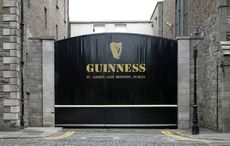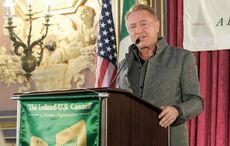If, in 1964, you were to have asked me which two things excited me most, aside of course from ‘The Siren Call of Sex’ as the poet Philip Larkin put it, I would have answered, the Ronettes and the paintings of Francis Bacon. Oh, and the fact that I was leaving Hull College of Art intent on a life of painting, so three things.
The first Francis Bacon paintings I saw were in reproduction, around 50 years ago. They had a great effect on me even in this diminished form. I recall my painting tutor, James Neill, being scornful of Bacon’s work. Telling me that Bacon was passé. The years leading to the current exhibition at the Metropolitan Museum of Art in New York show how wrong he was. The works reverberate with the energy of the painting and the violent intensity of the imagery they contain.
Bacon said that one reason for the violent component of his paintings might have to do with his upbringing in Ireland. He was born in 1909, a century ago in Dublin, the son of a racehorse trainer. They lived quite near the Curragh where the British Cavalry Regiment was stationed. He remembered them using the drive to their house for practice maneuvers, galloping up and down the drive. This was just before the 1914 war. The family moved to London in that period because his father was in the War Office and Francis was instilled with the possibility of impending danger. After the war he returned to Ireland and was raised during the period of the Sinn Féin Movement, living with his grandmother who was at that time the wife of the Commissioner of Police for Kildare. He remembered living in a sandbagged house, and some roads crossed with ditches dug, said Bacon, to trap the unwary car or horse and cart for the waiting snipers.
When he was 17 he moved to Berlin. He said the Berlin of 1927 was violent, not in the military sense that Ireland was, but in the emotional sense. One thinks of Christopher Isherwood who lived in Berlin around the same time and later wrote Good-bye to Berlin, which was made into the musical Cabaret. One thinks of the latent violence too soon to become a reality that Bacon spoke of. For a young gay man it must have been very exciting, and later very dangerous. He went on to live in Paris during “all those disturbed years,” as he put it until 1939 when the war started.
What Bacon said about the violence of his life, the violence he has lived amongst, is that it is different from the violence in painting, “that to speak about the violence of paint, it has nothing to do with the violence of war, it’s to do with an attempt to remake the violence of reality itself.”
Bacon himself was obsessed with mortality and said that “If life excites you then its opposite, like a shadow, death, must excite you,” that one is aware of it like the flip of a coin between life and death. In an interview with the writer and art critic David Sylvester, Bacon said he was always surprised when he woke up in the morning. Sylvester asked if that didn’t belie Bacon’s view that he was an essentially optimistic person, and Bacon replied, “Ah well, you can be optimistic and totally without hope.” That seems pleasingly Beckett-like to me.
The visitor to this magnificent exhibition, if not already familiar with Bacon’s work, may be surprised; perhaps even a little shocked if that is still possible today, at the visceral quality of the painting. Near the beginning of the exhibit is a triptych “Three Studies for Figures at the Base of a Crucifixion,” painted in 1944. The phallic figures are against a stark orange background; one looks down while the other two with snarling and gaping mouths evoke menace or pain. Bacon said that he was influenced by Picasso’s paintings of organic forms relating to the human figure but distortions of it. But the mouths, full of teeth in the Bacons, make his work altogether more sinister.
Bacon said he did hope one day to make the best painting of the human cry, but that he was not able to do it. He thought the best depiction of the cry was in the still from Eisenstein’s great film Battleship Potemkin of the screaming nanny. In painting, he felt the best human cry was probably in the “Massacre of the Innocents” by Poussin of around 1630.
Again and again one can see the importance of the mouth as an expressive vehicle in Bacon’s works. When young in Paris he bought a second-hand book with hand-colored plates of diseases of the mouth. He tried to combine the Potemkin image with the images from the book, but it never worked out.
A friend once gave me a textbook of reconstructive surgery of victims of traumatic injury (there is always someone wanting to cheer you up). One photograph showed a face with the flesh almost entirely lifted from one side revealing the teeth, jaw and skull. I always associated the image with Bacon – though Bacon’s paintings are neither horrific nor literal. Yet it is as if he reminds us of the skull beneath the flesh, reminds us of our mortality.
‘The mouth’ paintings evolved during the 1940’s. The work entitled “Painting 1946” has a dark figure whose jaw and mouth emerge from the adumbration of an umbrella. A flayed carcass is behind, its limbs spread as if crucified. This, the first work by Bacon to be acquired by a museum, was purchased by the Museum of Modern Art, New York, in 1949 and it seems to point the way to the ensuing works sometimes referred to as ‘Scream Paintings’ of heads, figures and Popes, in the 1950’s. “Study for Innocent X,” 1962, seems a culmination of these, being derived from a reproduction of the Velazquez portrait (widely regarded as one of the finest portraits ever painted). Interestingly, Bacon, though he spent two months in Rome, never visited the Galleria Doria-Pamphili to see the Velazquez painting. He said he probably feared seeing the original after he had tampered with it.
He needed only the reproduced image for his purposes. Bacon certainly preferred to work from photographs as a starting point, rather than with models, partly as he said because he thought that models would be upset by what he did to them.
There is a delicious painting called “Portrait of George Dyer riding a Bicycle,” 1966. Dyer’s face is turned to the viewer whilst surrounding it, a larger shadowy profile with a faint smile rides obliviously on. Dyer was Bacon’s lover, but their relationship was always tempestuous and in 1971 on the opening night of Bacon’s big retrospective at the Grand Palais in Paris, Dyer committed suicide in his hotel room.
I met Francis Bacon at the Chelsea Arts Club, London, which he occasionally came to in the late 1970’s, and in the 1980’s I’d occasionally see him walking in Kensington where I lived. He would nod but we never spoke. That was good enough for me. I met Ronnie Spector of the Ronettes too, but that is, as they say, another story.
David Remfry’s artistic career spans more than 30 years. A figurative painter born and trained in England, he is now living in New York City.
Three postscripts: The Chelsea Arts Club was a smoky club founded in 1891 at James McNeil Whistler’s suggestion for artists and other reprobates. Two large snooker tables dominated the large bar with a beautiful garden outside. It still exists although is no longer smoky.
The club that most often found Bacon in residence was The Colony Room in Soho. Founded in 1948 by Muriel Belcher who managed to get a drinking license that allowed her to remain open when public houses were closed, this tiny green room was a home to many famous artists including Dublin-based Lisa Stansfield and Barry Flannagan. John Edwards, companion of Bacon for the last 16 years of his life and sole heir to the Estate, donated the contents of the Reece Mews Studio to The Hugh Lane Gallery in Dublin where it was reconstructed as a permanent display in the gallery.




Comments